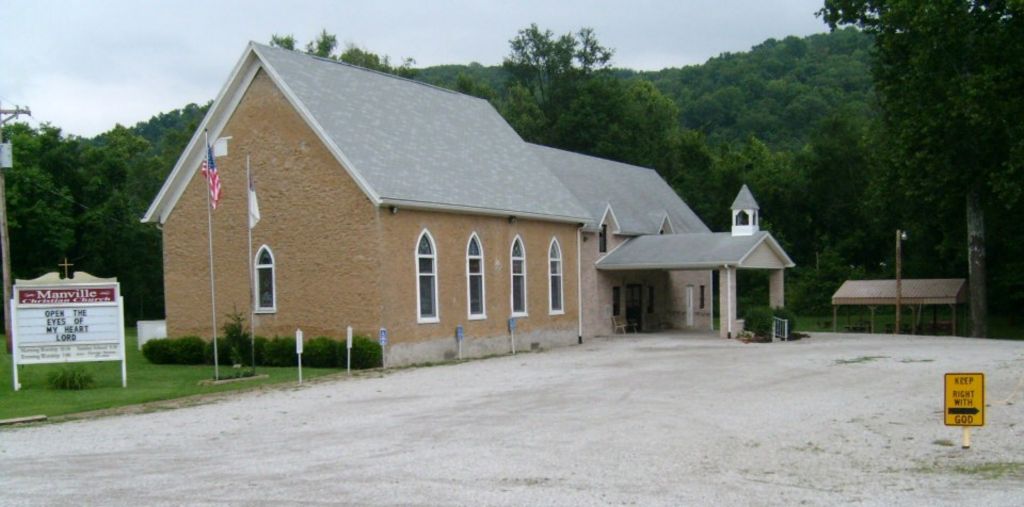
Note the sign in the parking lot, pictures taken July 2009, Photos first - then text from the Church web site, I took photos of stones that hopefully were readable.
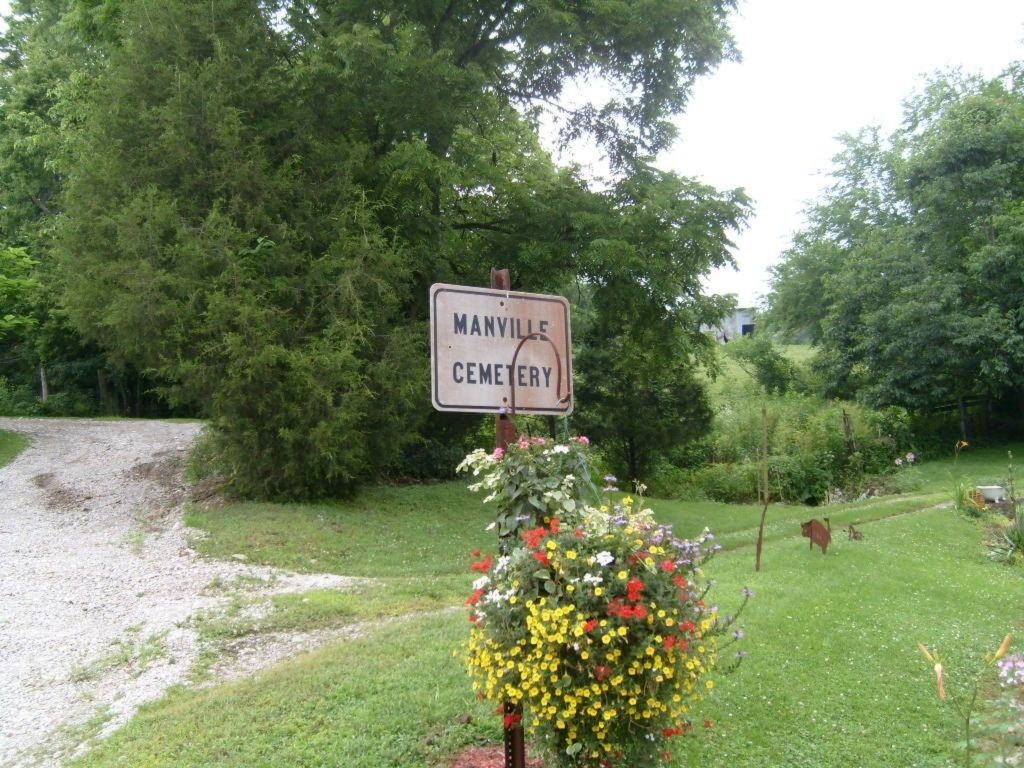
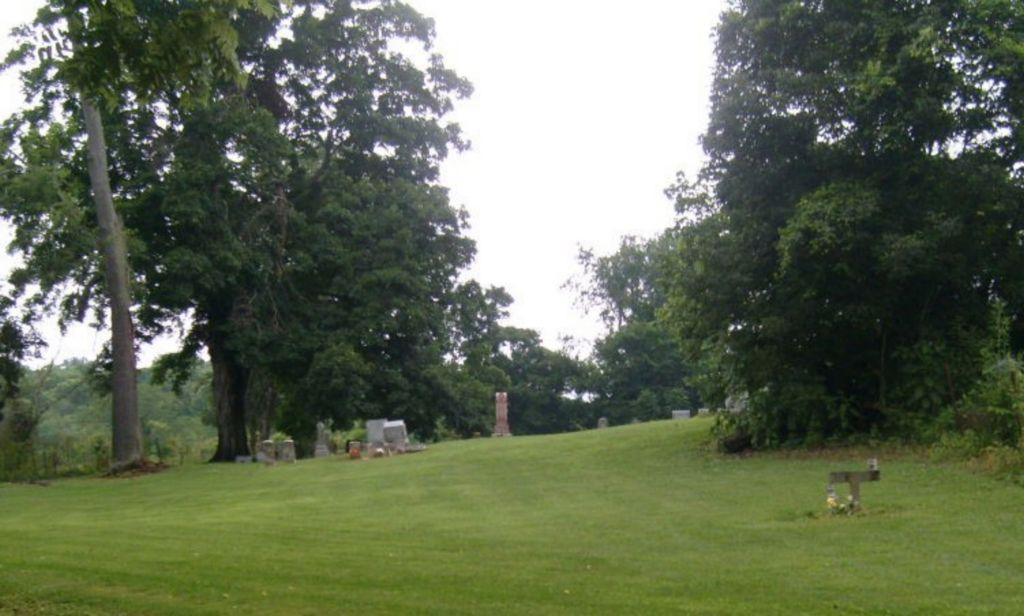
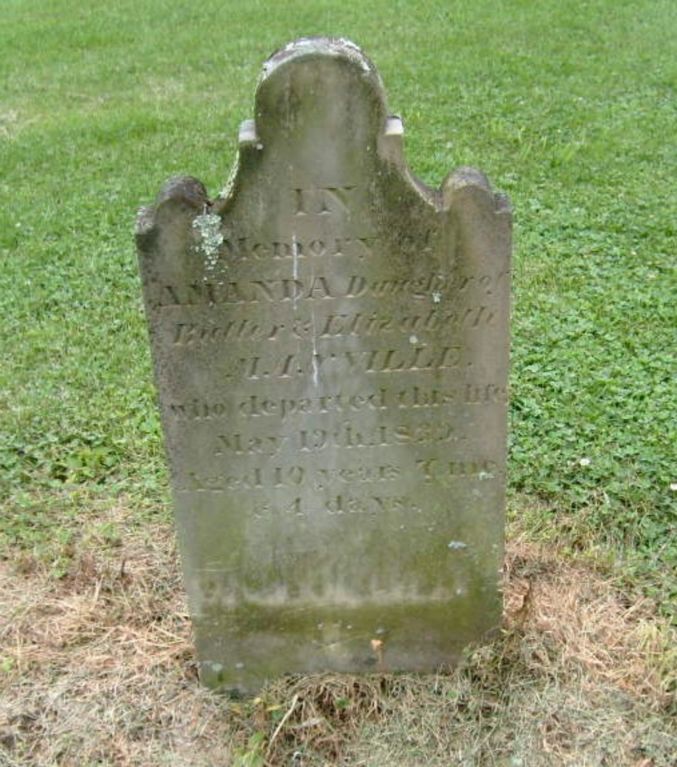
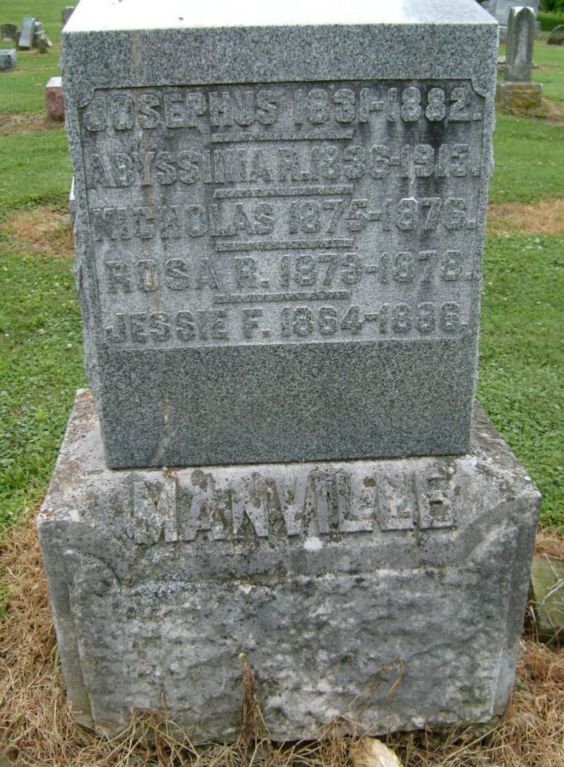
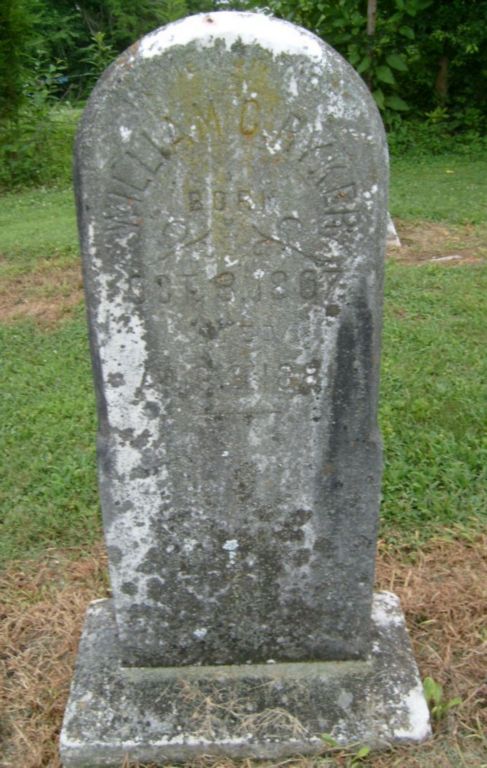
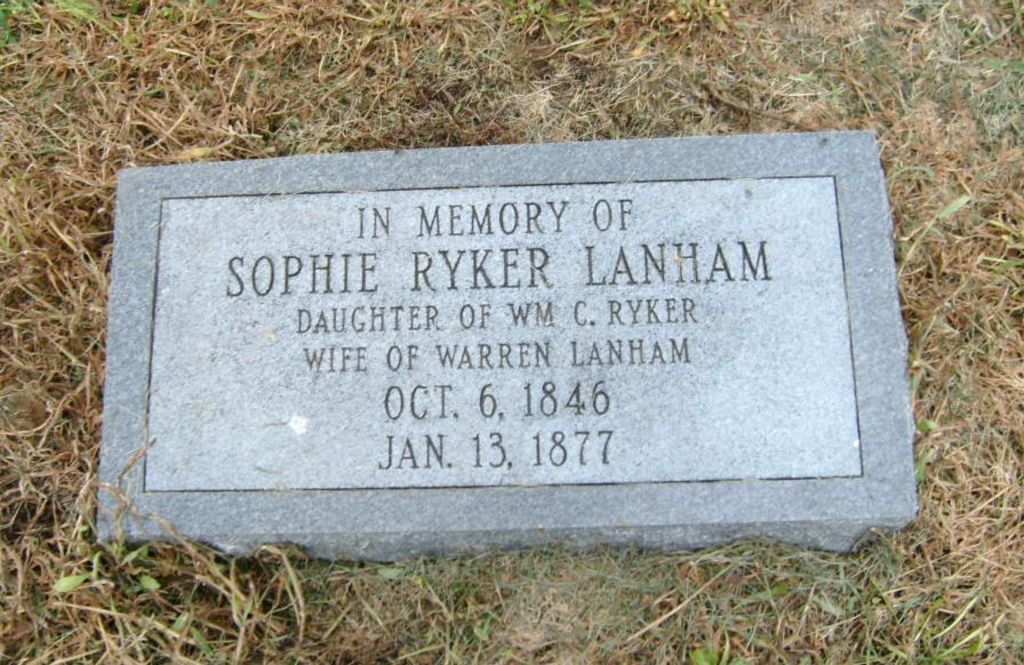
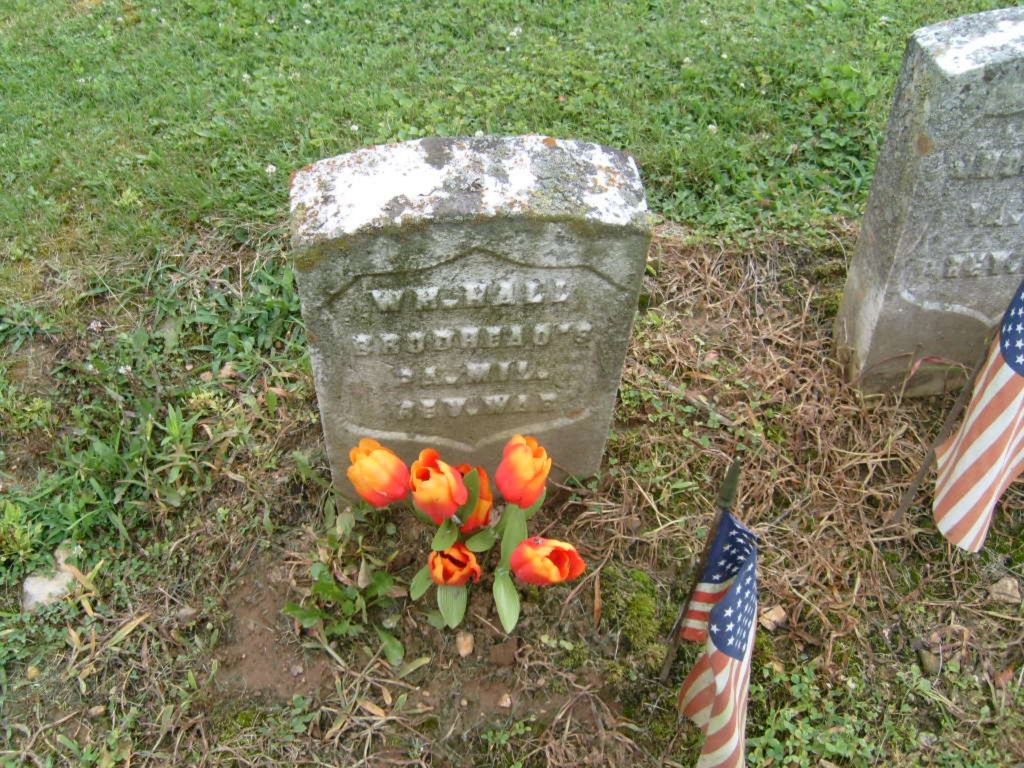
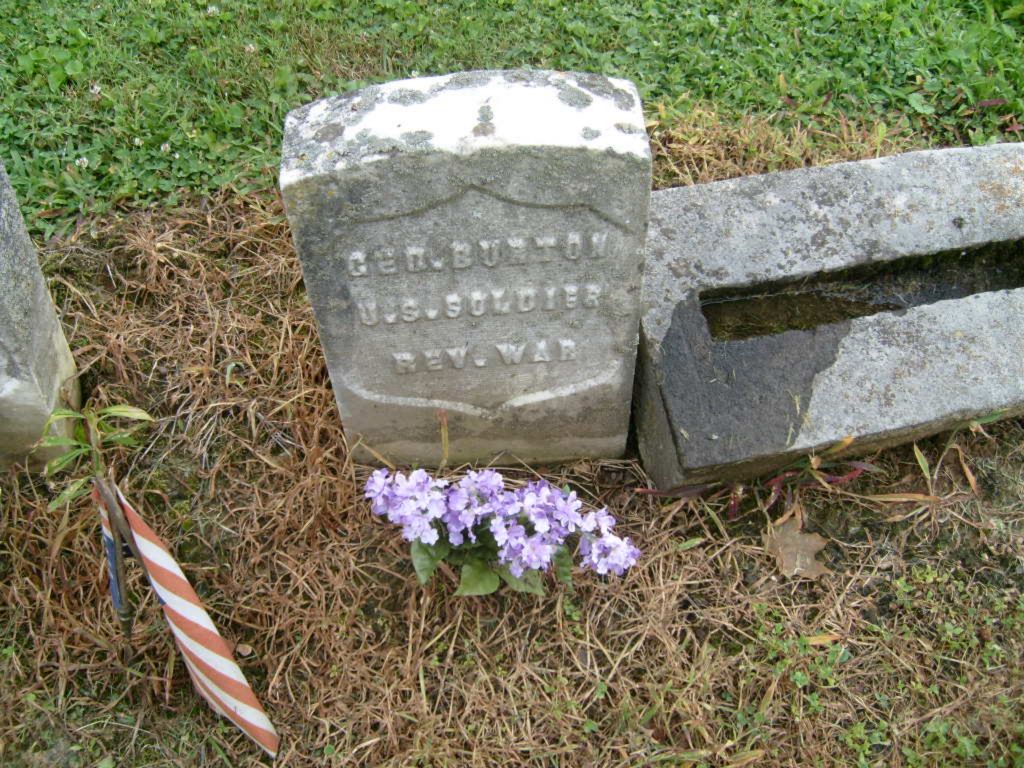
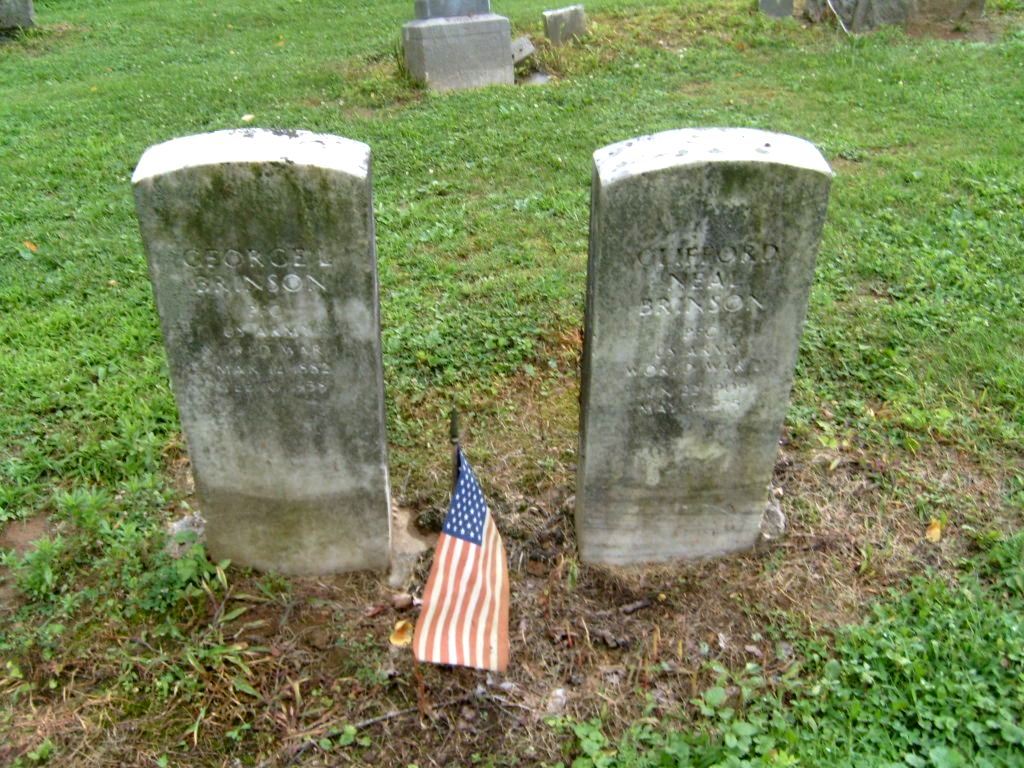
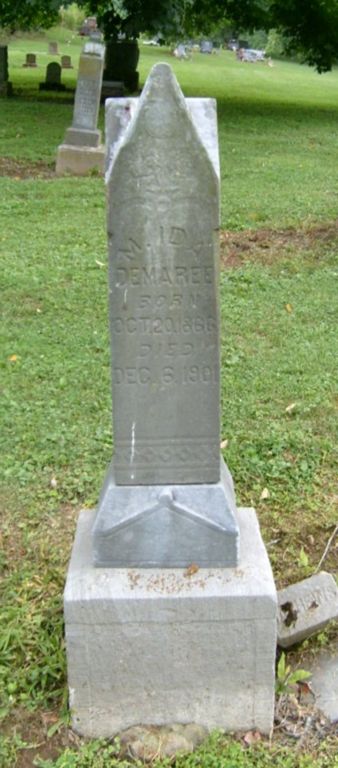
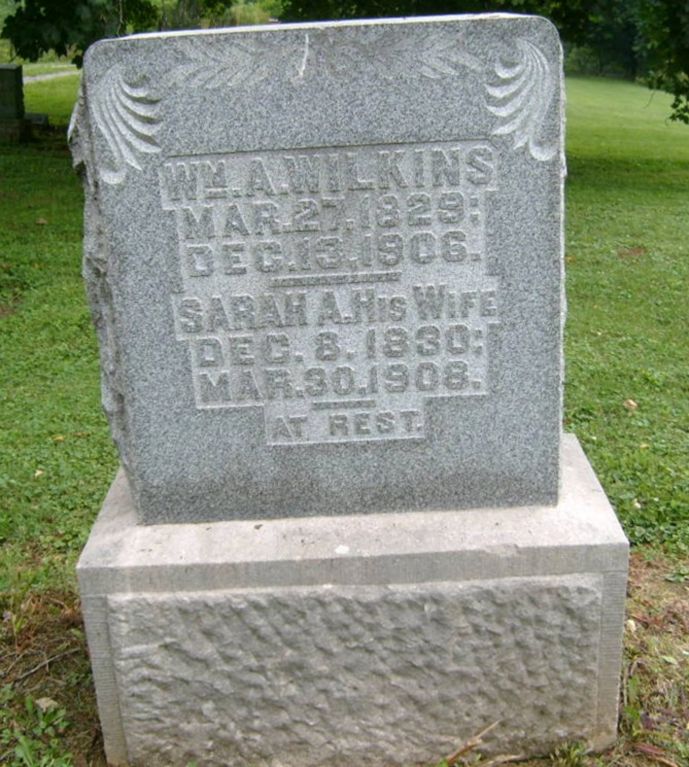
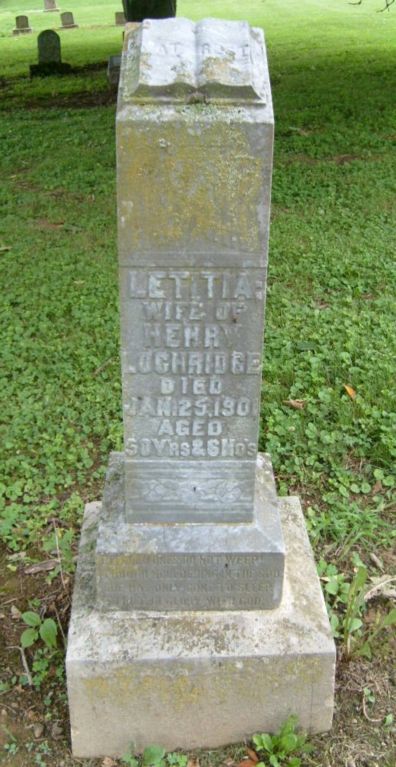
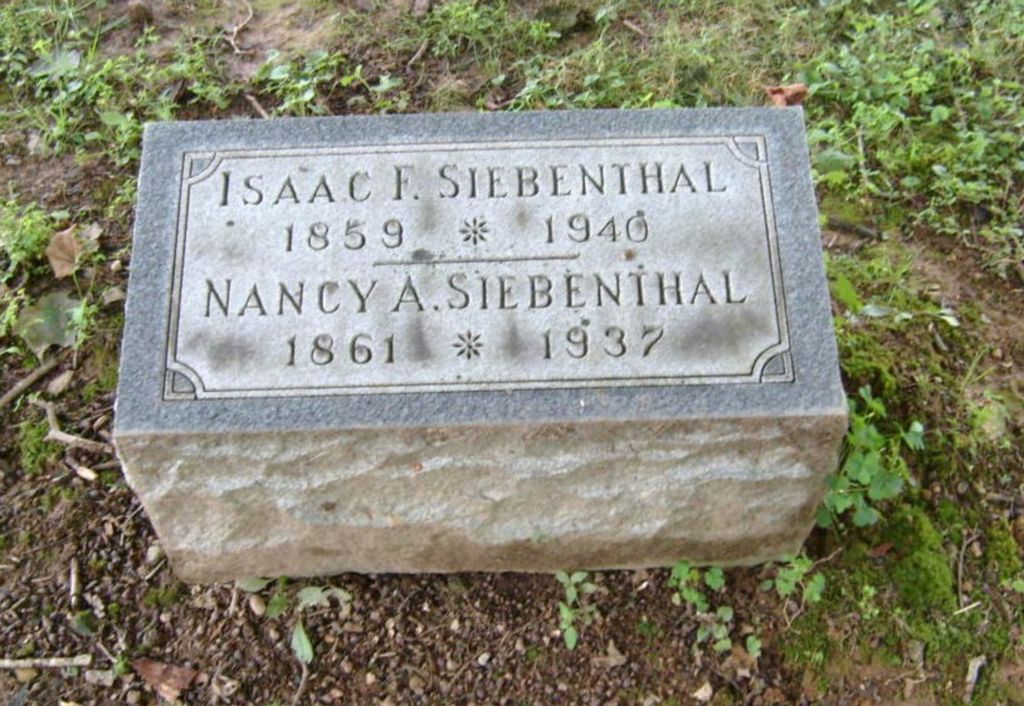
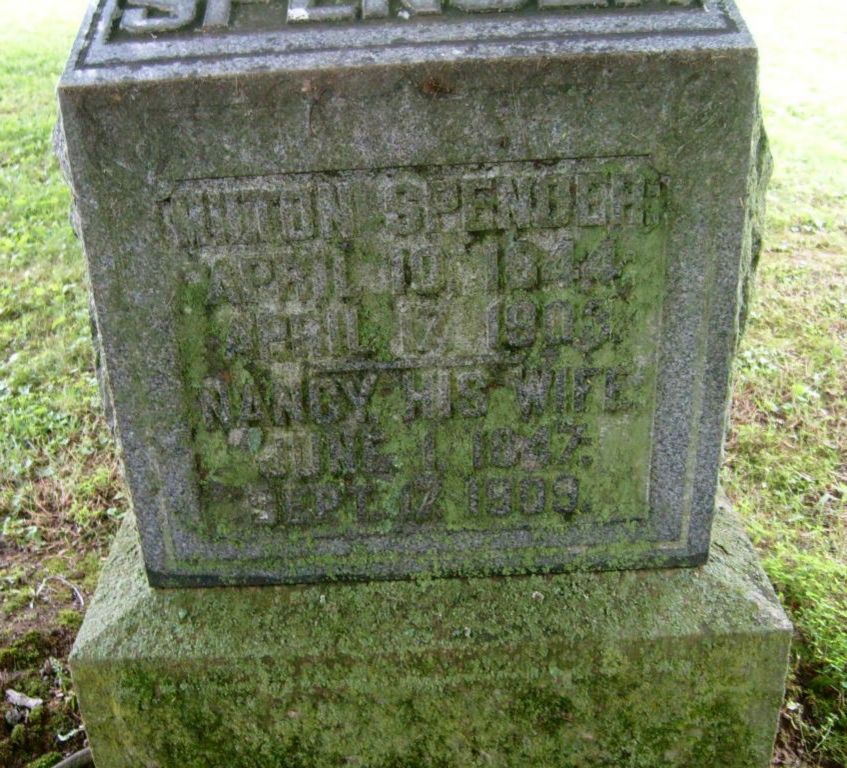
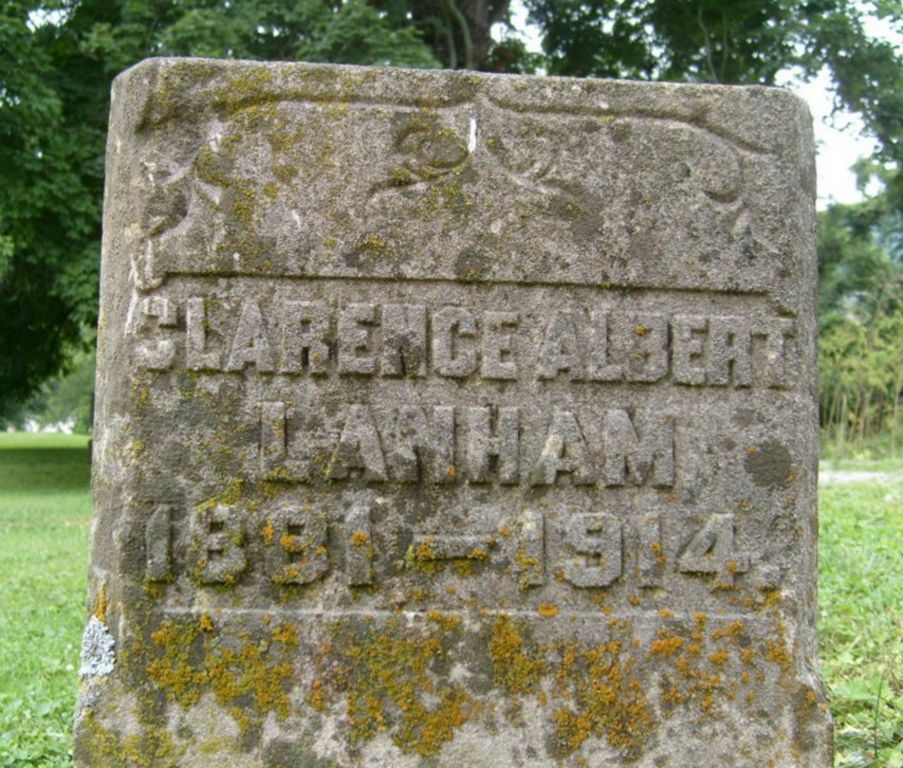
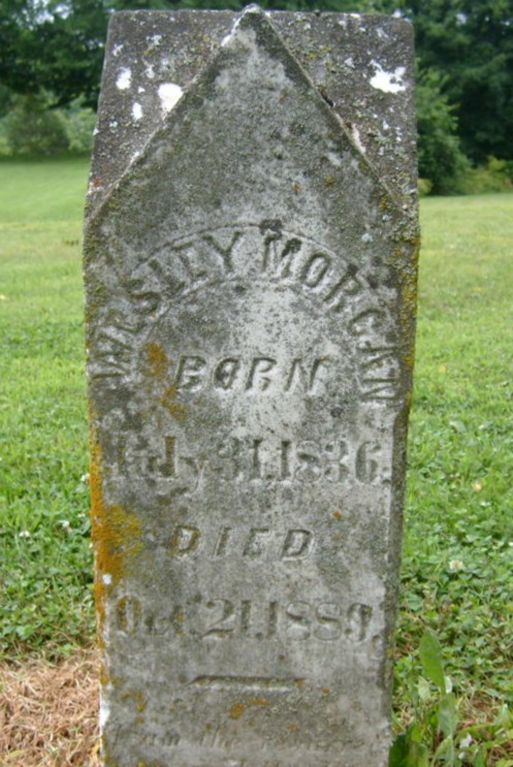
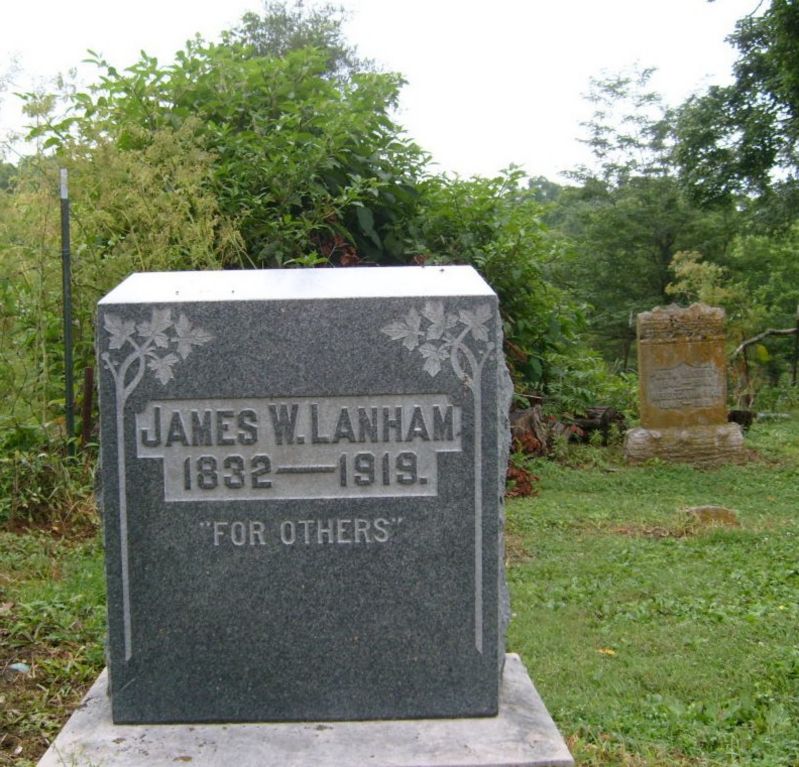
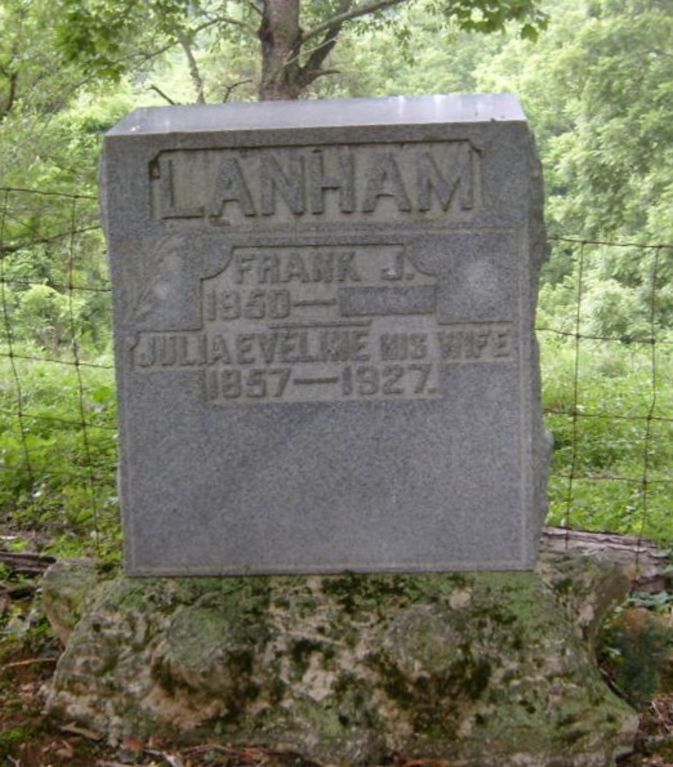
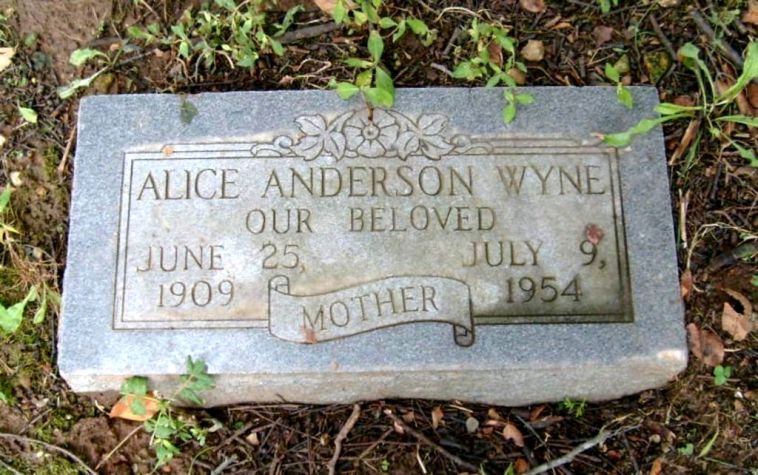
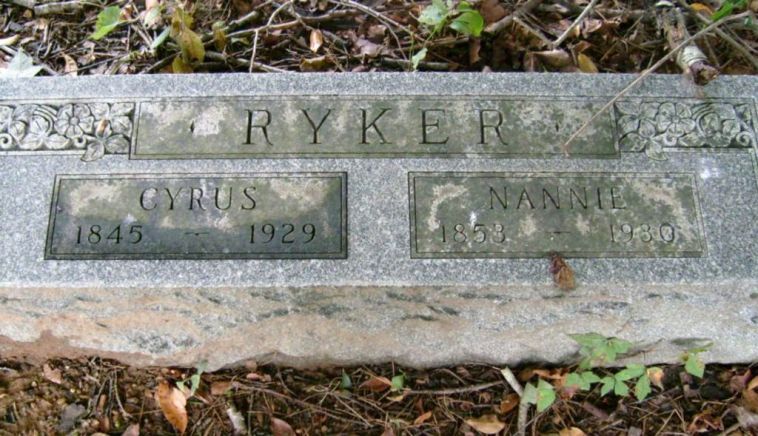
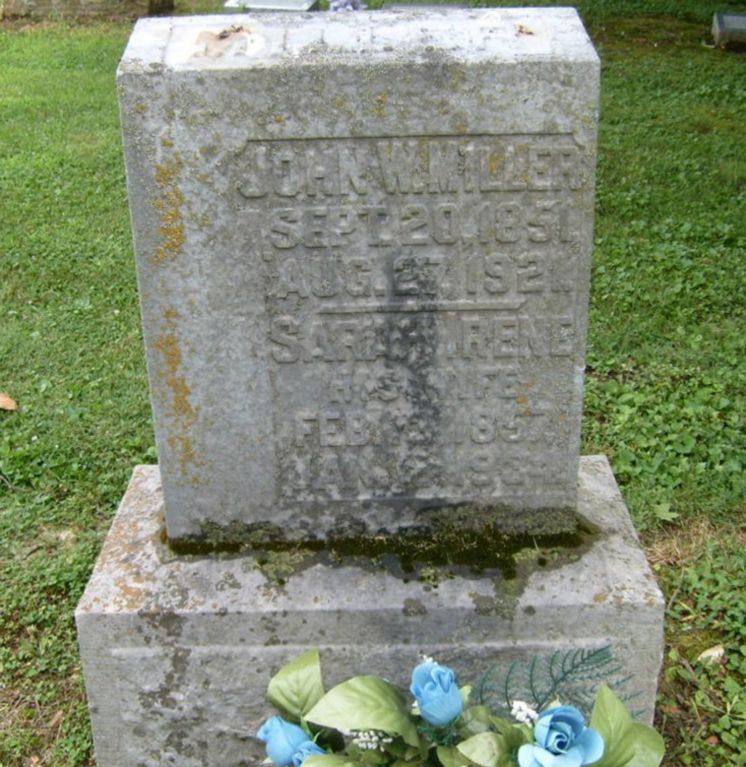
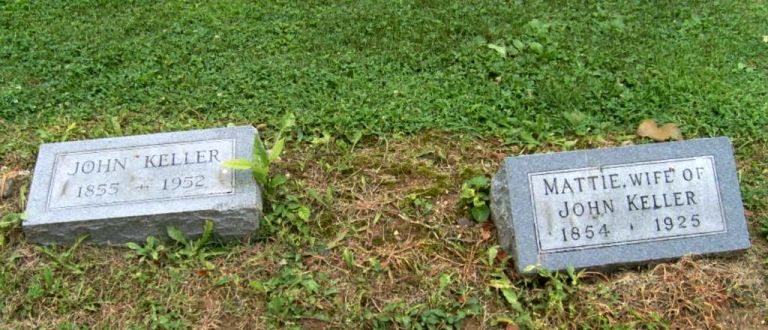
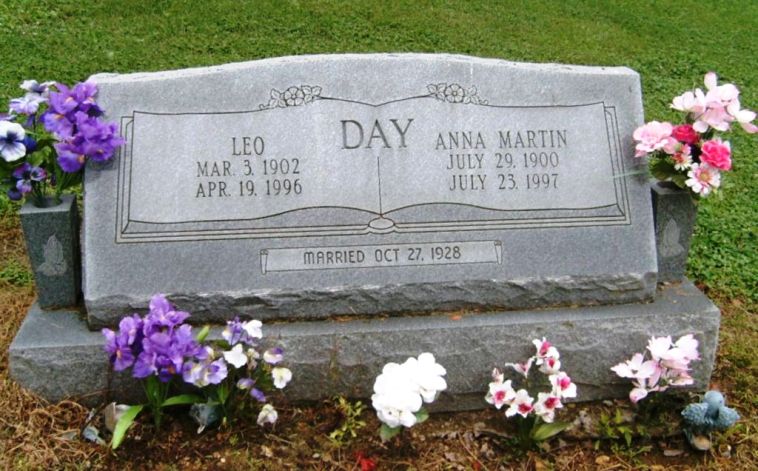
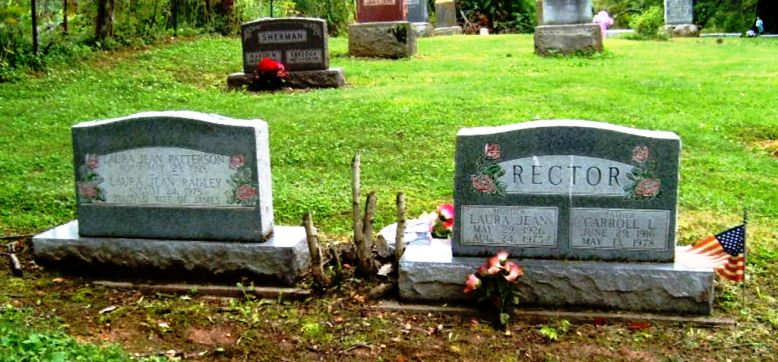
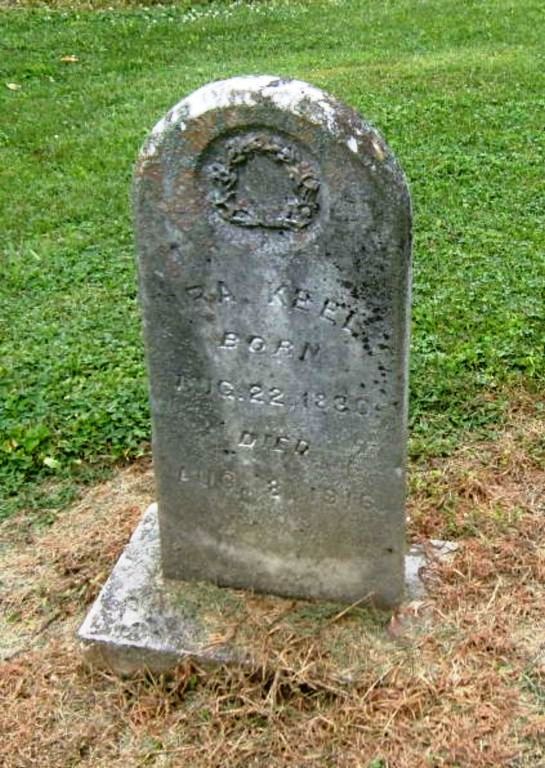
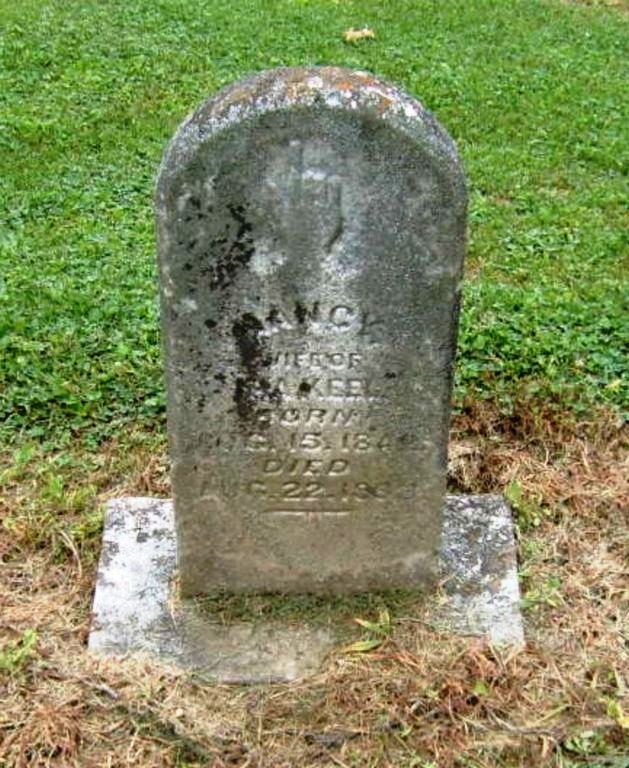
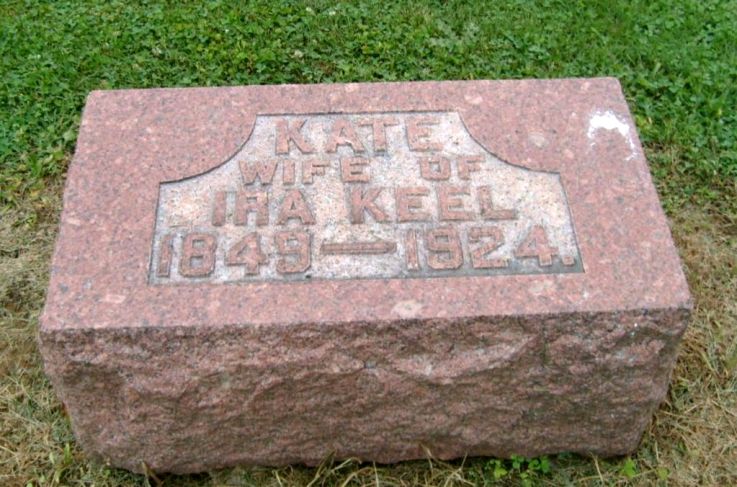
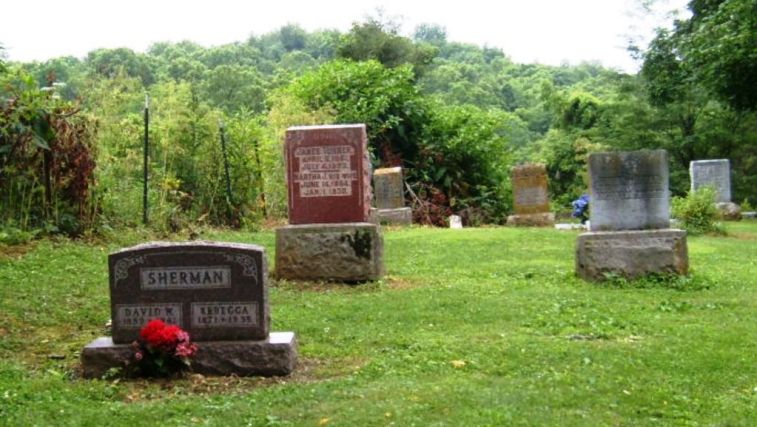
PREFACE
Most of the early history of the Manville Christian Church was handed me by either my dad, Silas Jacob Miller, or by my grandmother, Mary Melinda Jones Miller. I’ve picked up bits elsewhere including a record of the early history of the Church which is in the Genealogical Library of the Church of Jesus Christ of Latter Day Saints at Salt Lake City, Utah.
Grandmother Miller used to say she had been told there were burials on Cemetery Hill before 1820. The oldest stone with a date is around 1840. However, a paper in the Salt Lake City, Utah, Genealogical Library suggests there may have been settlement along Indian Kentuck Creek before settlement around what today is Madison.
THE FIRST CHURCH
Records say the first church in Milton Township was originally of Baptist denomination sometime in the 1820s. The church began with two preachers at the same time: Joseph Hankins and Elder Leavitt.
Jacob Short, who was a convert of Alexander Campbell, invited Beverly Vawter of the Christian Disciples Church to speak. His doctrine was accepted and sometime in the summer of 1830, the original Baptist organization became what is today Manville Christian Church.
Jacob Short was considered the father of the Church. The first members were Jacob Short, his wife, Elisha Short, and his wife.
The first ministers were itinerant; among them was Love H Jameson, John O’Kane, John B New, Asher Ward, and Newton Short.
When this new church was only two-years old, James W Lanham was born. He would figure prominently in the future of the Church.
Among the early pastors were: A H Ames and Charles Lanham.
While the Church was housed in a log structure in early days (the 1820s and into the 1830s) the present stone church was probably built in the late 1830s--sometime after 1838.
In the early years the Manville Christian Church was, in a fashion, the mother of the Milton Baptist Church (later known as the Brooksburg Baptist Church) located two miles northeast of Manville. Later some members of this second church went on to form the Mt Pleasant Church on Halls Ridge.<
THE CHURCH IN THE 1850s
James W Lanham, the young man born shortly after the Church was formed in 1830, became the minister in 1853. In 1851 "Preacher," as he was known by the congregation, was baptized in Indian Kentuck Creek near the stone church. Shortly after he began to preach at Pleasant Ridge and then in late 1853 or early 1854, he became the minister at his home church.
The Church survived the big flood of 1857 which swept most of the homes from the bottomlands. From that point on, the Church was a landmark in the valley.
The youthful minister became an outstanding revival leader and the Church and the minister were known for miles around.
In the late 1850s Preacher Lanham began to build a library at his home for use not only by the members of his congregation, but other neighbors as well. Some have said it was the first lending library in Indiana. It contained the latest journals on religion, agriculture, forestry, livestock and poultry.
THE CHURCH IN THE 1860s
Preacher Lanham was opposed to slavery and had once turned down a teaching position in Kentucky because of the views there. A house not far from the Church was known as an underground railway station. However, no mention is found in records as to the stand of the Church at the time.
Preacher Lanham, now a well-known revivalist, became active in politics and the community became a key point in political campaigns. The Church seemed to be a center of activity.
THE CHURCH IN THE 1870s
Preacher Lanham began to take a stand on many of the day’s issues and friends had his name placed on the ballot for the Indiana Legislature. He was elected to the House in both 1874 and 1876, but was defeated when he ran for the State Senate because of his strong stand on the temperance issue.
THE CHURCH IN THE 1880s
The decade of the 1880s centered on whether to build a new church or remodel the stone church. The old stone church won, and among changes was a raising of the pitch of the roof which is still noticeable on the upper stonework. It is believed this change was completed about 1889. Meanwhile, new hymn books, THE CHRISTIAN HYMNAL, were acquired in 1882.
THE CHURCH IN THE 1890s
In this decade of the 1890s, a campaign was started to acquire stained glass windows for the Church. Today these old windows are considered some of the most beautiful in the area. The window behind the pulpit was given by Dr Charles Ryker as a memorial to his daughter, Pearl, who had been the Church organist for a number of years. It reads: "PEARL M RYKER, Born Nov. 11, 1868, Died Aug. 16, 1892." Another window honors John Yates, 1816-1875.
During this era the Church probably reached the height of its membership and activity with many youth programs that were known for miles around. It drew crowds of young people at services, many times with standing room only. In the summer and fall as well as spring, the windows were opened so those outside could share in the preaching and singing.
Among the youth programs that gained recognition were a choir, gospel singing group, debating society, fife and drum corps, theater group, and the Wednesday Night Endeavor. At the same time "Uncle James," as many of the young people called Preacher Lanham, reached his peak as a revivalist, conducting meetings in Ohio and Kentucky as well as Indiana. Meanwhile, many of these youth groups traveled in support of the church movement as well as in support of Uncle James. They traveled to such points as Vevay, Brooksburg, Belleview, Bryantsburg, Versailles, Cross Plains, and Canaan. They even took a boat to Ghent, Kentucky.
This was before the days of the auto and the airplane so travel
was by horse and buggy or hay wagon. Sometimes these groups did not get home
until the sun was up the following day.
An annual event sponsored by the Church —The Manville Picnic--, which had been held for many decades before, became much bigger. It drew hundreds and at its height was said to have drawn upward to 1,500 or more persons. For many years this giant gathering was held on the farm of William Moore on Brushy Fork. As dozens of young people had left Manville to find employment in Indianapolis, a special car would bring many of them back to Madison where friends and relatives would meet them to take them on "The Picnic, a giant homecoming.
For a number of years the Pennsylvania Railroad gave those returning for the picnic an excursion rate.
As the Church’s activity grew, some of it took space in the Manville Hall and in later years the Grange Hall, now (in 1980) Hamilton’s General Store.
THE CHURCH IN THE EARLY 1900s
Newspapers honored Preacher Lanham and the Church’s activity at the turn of the century. However, Preacher was now three score and ten and the youth were departing by the dozens for Indianapolis and the employment there. The young farm girls became housekeepers and cooks for the Indianapolis wealthy. The young men went to work as carpenters, many in the railroad shops around Indianapolis. Some worked on the truck farms (which raised garden produce for Indianapolis) south of Indianapolis.
The Church, in the early 1900s, considered calling Preacher Lanham for life as "Pastor Emeritus," but he would have none of that. Younger ministers did take over much of the pulpit duties but Preacher continued to minister to the sorrowing, conducted the weddings and funerals, and lowered the candidates for baptism into the water of Indian Kentuck Creek. The Honorable M C Garber of Madison, editor of Indiana’s oldest daily newspaper, The Madison Courier, said, "James W Lanham is my ideal of a rural American citizen. I have always admired him… He has been interested in all subjects, religious, agricultural, and humanitarian. His influence has been positive, clear-cut, and wholesome. His views, while always upon the right side, have not been extreme or fanatical."
"He has participated in all kinds of social movements, and has even been a successful politician, and withal, a clean honest, and honorable one. Such a man is, indeed, a bright and shining light in a community, a true exemplar, a desirable citizen, one whose life and career enable those who know him to place true values upon life and right living."
As Preacher Lanham stepped down from much of the pulpit duty, there remained a demand for his sermons. So in 1911 a book THRILLING THEMES IN THEOLOGY – Sermons by J W Lanham – Pastor of the Manville Christian Church at Manville, Indiana for Fifty-Four Years, was published. The book was a best seller in the Indian Kentuck Valley. Nearly every family acquired one or more copies. They were ordered by the dozens by the youth of the 1890s who were now young adults in Indianapolis. They were sold at the General Store. However, Preacher himself gave dozens away to his friends and neighbors. To the young man on the adjacent farm, Silas J (Si Jake) Miller, Preacher gave a copy signed in his own hand, Silas J Miller – A souvenir of Friendship and Brotherhood from the Author – J W Lanham. This was one of the first copies Preacher gave out and it was delivered one morning as Si Jake was hauling a load of fodder in from the cornfield.
As to Sunday School, a newspaper clipping of 1879 noted there had been Sunday School for youth for 50 years, mainly for youngsters. In June 1910, an adult Bible Class was organized but from the record it seems it was mainly for women. Officers were: Mabel Lanham, President; May Rogers, Vice-President; Lizzie Miller, Treasurer; and Leota I Lanham, Secretary. A membership committee consisting of Nellis Spencer, Zella Rogers, Ella Mae Wilson was appointed. The goal was two percent, then build to three percent. During the first few weeks of the life of this class, attendance ran from 3 to 6 persons and collections ran from 8-cents to 13-cents. Lizzie Miller and Sula Spencer were named to head a Social Committee. With so many mirgrating to Indianapolis, attendance and financial support were not the same as it had been in the 1890s.
THE CHURCH IN THE EARLY 1900s(continued)
The entire community suffered hardship from around 1900 on. The youth and many adults were leaving. The upper bridge washed off its foundations in a major flood coming down the Indian Kentuck Valley in early September 1904—a flood which again wet down the Church. There were a few automobiles showing up at the General Store. The lodges, which met at the Hall, lost support. Church attendance dropped. Then World War I took more away.
LEST WE FORGET
An obituary newspaper clipping on file with the Disciples of Christ Historical Society, 1101 Nineteenth Avenue, South; Nashville, TN 37212, is headlined, "Lest We Forget." The clipping reads, "James W Lanham was born Jan 31, 1832, at the home where he died, December 1, 1919. His age was 87 years, ten months."
The item continues, "He was a student, for some years at Hanover College" (he enrolled in the College’s Grammar School in 1853, then as a Freshman in the College in 1854.) "and throughout his life maintained a high regard and affection for this institution and his former teachers."
"He was a successful teacher in the common schools of Jefferson County and was the first teacher of Ryker’s Ridge High School."
"His ministry to the churches at Manville, Salem, Liberty, Madison, Edinburg, Lexington, Indianapolis (this while serving in the Legislature) and Pleasant Ridge were all productive of much good."
"He was careful in choosing his position on any question, and always stood for justice and righteousness and Christ. He was a man of more than ordinary courage and was always true to his convictions or right."
"He was a frequent contributor to religious periodicals and also found time to write a volume of sermons which has been widely read and productive of much favorable comment from many capable students."
"His good influence is with us yet and will continue throughout all time."
The Rev James W Lanham was buried on Cemetery Hill near the Church he had served for nearly 65 years. The funeral services were largely attended, conducted by John W Moody of Madison, President W A Millis of Hanover College, and Fred R Davies.
It was said he never fought Methodists, Baptists, or Presbyterians. He was "just out to win souls for Christ." Although his sermons were always of 27 minutes in length, he once admitted to a friend that he doubted if many souls were saved after the first 15 minutes.
AFTER PREACHER
Some would say the Church struggled after Preacher’s passing. However, as it recognized the 50th anniversary in 1880, it recognized the 100th in 1930. Many former members of the congregation returned from Indianapolis, Madison and elsewhere. Silas J Miller reported it was a "big day with a big crowd."
After struggling for many additional years the Church found new life in the 1960s.
THE 1960s AND ON TO 1980
In the early 1960s a new interest seemed to take hold of the congregation. The Church was better maintained and during the ministry of Brother Bill Adams, a drive found support to repair the stained glass windows. A later drive brought new pews, many in the form of memorials.
Other improvements were made during the most recent 20-year period including rooms for Sunday School and a vestibule at the entrance of the Church.
Committees have been extremely busy during the past months preparing
for the 150th anniversary, July 11 – 13, 1980. It will be a weekend long
remembered.
AN EARLY HISTORY OF MANVILLE CHRISTIAN
CHURCH
Presented to the Congregation May 22,
1990,
At the One Hundred and Sixtieth
Anniversary
Researched and compiled by Tom Carter –
October 2, 1966 to March 26, 1967
As some of you may know, the Christian leaders of the first and second centuries have strangely become identified as The Apostolic Fathers, an honorary title which identifies them as associates or confidants of the apostles, the apostles by this time having all passed on to their reward.
Perhaps, in a similar way we see a like feeling of veneration conferred upon those early fathers of the Christian Church in America.
It is not difficult to obtain this historical information as all you have to do is go to the historical section of the Madison Library, take down a copy of Thrilling Themes in Theology by J W Lanham and feast on the glorious history of the "Restoration Movement" in Indiana.
I’m proud to have come from a state much like Indiana in that it also had a glorious history, but Virginia’s history has been more notable in the founding of a great nation than it was in the great victories won by humble men of faith who through the preaching of the simple gospel of the early Church inspired the greatest revival in American history here in the western reserve among the farmers and working people, and not by sending their sons off to be killed fighting for their country.
I do not in any way want to demean those who fought and died to make this land free, for they fought and died not only to set us free from Tyranny but also to secure for us freedom of worship.
In fact, I might add, I happened to be one of those young men who were called upon to defend those freedoms fifty years ago. But it didn’t cost me my life, just my wife and perhaps some people would consider me lucky and as a matter of fact, perhaps I was, when you read of the sacrifices of those early preachers of the "Restoration." Take Elder Raccoon John Smith for example, West in his Search for the Ancient Order, Vol 1 tells of the great tragedy in his early life as a preacher. He tells us, "Misfortune frequently followed Smith and the first of any serious consequence met him in Alabama. He was off preaching. His (beloved) wife left their cabin to care for a sick neighbor. The children were left at home with Hiram Townsend, brother to Smith’s wife. Suddenly, the cabin caught fire and quickly burned to the ground. Two of the children were burned alive. The terror and horror that struck Smith’s wife can only be dimly imagined. The sad news reach Smith and he returned home as quickly as possible. His wife, like Rachel, would not be comforted. The days passed by and she sank lower and lower only to be finally planted beneath the soil beside the ashes of her two departed children. Smith himself got sick. He contracted a fever and for days hovered near death. Slowly he improved.
In a matter of months he sold the farm and started retracing his steps back to Kentucky."
I only related this story to show that those early men often faced tragedies as great as some who went to war, and still persevered, later to perform great works for the Kingdom of God.
Of those, not so well known preachers in the early days of the "Restoration’s" glorious history in Indiana was Love Jameson born May 17, 1811, and baptized upon the simple confession of faith required in the N T and doubtless one of the earliest young men to commence preaching at Manville. Baptized in 1829, he began preaching at the request of Beverly Vawter, an aged preacher in the Manville area, delivering his first sermon on the evening of December 29. For several years his labors were confined to Jefferson County and adjacent regions, but in 1834 he visited Southern Ohio, where he labored with success for several years. There he formed the acquaintance of several prominent preachers, among who were D S Burnet, L L Pinkerton, J G Mitchell and Walter Scott. The last mentioned made an impression upon the young preacher from Indiana which he carried throughout life.
At that time Walter Scott was regarded as second only to Alexander Campbell. He was a man of genuine piety and a speaker of sublime and fervid eloquence. But, to him at least, life was not a dead level; he was not always at his best. Adverse influence would at times beat down his lofty spirit, as the storm beats down a soaring bird. Scott and Jameson went to Harrison, Ohio, to fulfill an appointment. Carey Smith of Indianapolis had arrived before them. When they met Smith he informed them that all of the churches in the town were locked against them and that the meeting would be held two miles west of the village in a barn in Indiana. When they arrived at the place they found a congregation of about thirty persons. Scott, being seized by one of his moods of depression, wrapped himself up in his great cloak, stowed himself away in a hay mow, and went to sleep. Smith preached a good sermon, Jameson delivered an animated exhortation and several persons presented themselves for baptism. Brother Scott, wakened either by the exhortation or the singing, hastily left his retreat and heartily joined in the exercises, not even stopping to brush the hay seed from his raven locks. After this the barn was regularly filled, and soon a church was organized which still continues to flourish.
Mr Jameson, after abundant labors in Ohio, Kentucky and Indiana, accepted a call from the Church in Madison, Indiana, having been married in 1837 to Miss Elizabeth Clark, a woman of most excellent spirit. His labors in Madison began in 1841 with bright prospects, which were soon buried in deepest gloom. His wife, walking in the garden near the close of day, was suddenly seized with apoplexy and died almost immediately. The mental shock was too much for him. He was stricken down with fever, and lay at the old homestead for many weeks, his life trembling in the balance. During the period of his illness he was attended by Doctor A H Ames, a brother-minister and intimate friend and, for many years, the minister of the Church at Manville, Indiana.1
1James W Lanham, Thrilling Themes in Theology 1910.
Brother Jameson was well qualified to profoundly impress the young convert with the significance of the step he was taking. Brother Lanham’s tribute to Jameson, as it appears below, attests to the love and admiration he cherished for the one who inducted him into the Kingdom and patience of the Lord.
He later called him,"That sweet singer, strong preacher, the man who in magnanimity and graciousness shines like a star in the galaxy of Indiana’s great sons of the Reformation."
Certainly the Christian Churches of Manville and Madison can be proud of the dedicated men of faith that have come out of the families of their congregations and neighboring churches.
As one looks back to those early years of the Restoration, he notices that many of the leaders from Kentucky such as Barton Stone, Walter Scott, Elder John Smith, Philemon Vawter, John T Johnson and John Rogers were instrumental in bringing about unity in Indiana. The union of Reformers and Christians being the goal of those preachers both in Kentucky and Southeastern Indiana.
The great elder Raccoon John Smith, speaking for the Reformers in Georgetown in 1831, put it this way:
"While there is but one faith, there may be ten thousand opinions, and hence, if Christians are ever to be one, they must be one in faith, and not in opinion."
"Let us, then, my brethren, be no longer Campbellites or Stoneites, New Lights or Old Lights, or any other kind of lights, but let us all come to the Bible alone, as the only Book in the world that can give us all the LIGHT WE NEED." 2
Concerning union in Indiana, Enos Dowling says, "About this time a union was being affected between the Christians and Reformers in eastern Indiana also under the labors of John Longley (Christian) and John P Thompson (Reformer). Longley wrote to Stone on December 24, 1831: ‘The Reforming Baptists and we are one here.’ An earlier movement for union had developed in southern Indiana under the leadership of John Wright, a Free-Will Baptist. Wright held that all human creeds are heretical and schismatical, and that the Bible was a sufficient guide for all Christians. In 1819 he persuaded the Blue River Baptist Church to drop its creed and sustain itself on the Bible alone. Within two years the churches forming the Blue River Association had accepted Wright’s position and disbanded as an association. The Dunkards and New Lights soon joined these reformers. By 1828 union was practically complete among these groups. Uniting with them later were the Regular Baptists forming the Silver Creek Association influenced by Absalom and John T Littell and Mordecai Cole." 3
As Raccoon John Smith and John Rogers were "riding together" and visiting the churches, in order to make them acquainted with what had been happening and persuade them to similar action, "in Kentucky the Reform Movement had already caught fire on the other side of the river where John Longley and John P Thompson had been visiting and on December 24, 1831, Longley wrote Stone, "The reforming Baptists and we are one here." 4
2 J A Williams, Life of Elder John Smith, pp 453, 454
3 Enos Dowling, The Restoration Movement, Standard Publishing Co. 1964.
4 Ibid p 70
Although the exact date of J W Lanham’s birth I did not establish in my research from other dated events in his life, the early twenties would seem a reasonable guess since he started preaching in his mid-twenties and preached for over sixty years.
After a brief visit to Kentucky at the invitation of Philemon Vawter and some exciting experiences with those well-known older preachers, the young preacher returns to his home resolved to settle down and accepts a call to the Church in Lexington, "preaching at the same time at Manville and at Salem (in) Ripley County, once a month each. At all his preaching points he repeats the success he had at Pleasant Ridge, (his first ministry) and there are many additions to the churches. At the breaking out of the Civil War he resigns at Lexington and shortly after takes work at Liberty, where for many years, with some intermissions, he ministered; but at Manville he remained for about fifty-five years. In the very beginning of his pulpit work he is recognized as an able evangelist. He held many successful protracted meetings and might have attained pre-eminence in such work; but he became convinced that he should give more time to the care of the churches; it is one thing to move men and women to enter the Kingdom of Jesus; it is quite another thing to so lead them in all Spiritual truth as that they will come to maturity. Brother Lanham has proven himself to be adept in such leadership."5
No history is ever complete for history is made day by day by those dedicated men and women who continue to give of themselves and their labor of love for the Master. Time would fail to list even some of the many known to the writer alone; however it seems appropriate to make special mention of one family whose members have served the cause of Christ from the earliest days of the Manville Church even down to the present.
The Lanham family has been in continuous dedicated service, first in the Church and now in the Mission Field of Brazil, S A, from the very beginning of the Restoration Movement in Southeastern Indiana, what a glorious contribution and labor of love!
Brother Paul and Shirley are and have been in Brazil for the past thirty years. For some twenty years of that time two, until now, unknown saints served as the Lanham’s forwarding agents keeping funds flowing to Paul and Shirley, Brother Ivor Reed and his good wife, Jane. Mr and Mrs Ernie Moreland, for the last ten years, have assumed the labor of love for those aged saints as they now await their final reward. Their names are also surely written there, in the Lambs Book of Life.
Researched and compiled by
Tom Carter
5 James W Lanham, THRILLING THEMES IN THEOLOGY, 1910.
I can take absolutely no credit for anything but the above pictures, the
Church History was written by members and is on their web site at
http://manvillechristianchurch.com/
Here
is a link to a listing of this cemetery at Ruth Hoggatts - My Indiana Home web
site - done by Robert Scott
http://www.myindianahome.net/gen/jeff/records/cemetery/milmanv.html
RETURN TO TABLE OF CONTENTS